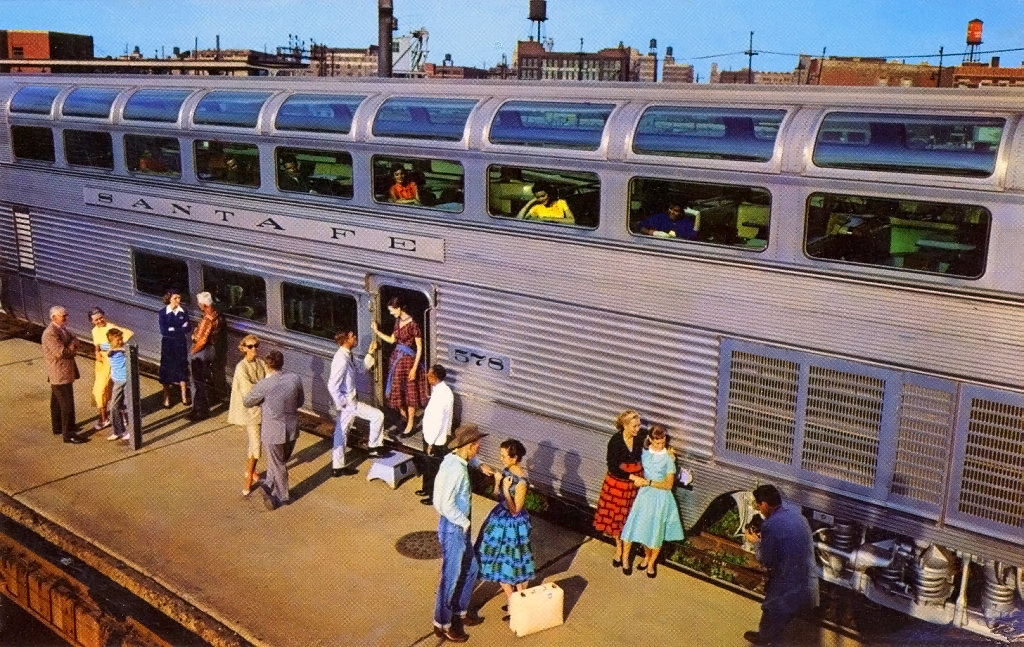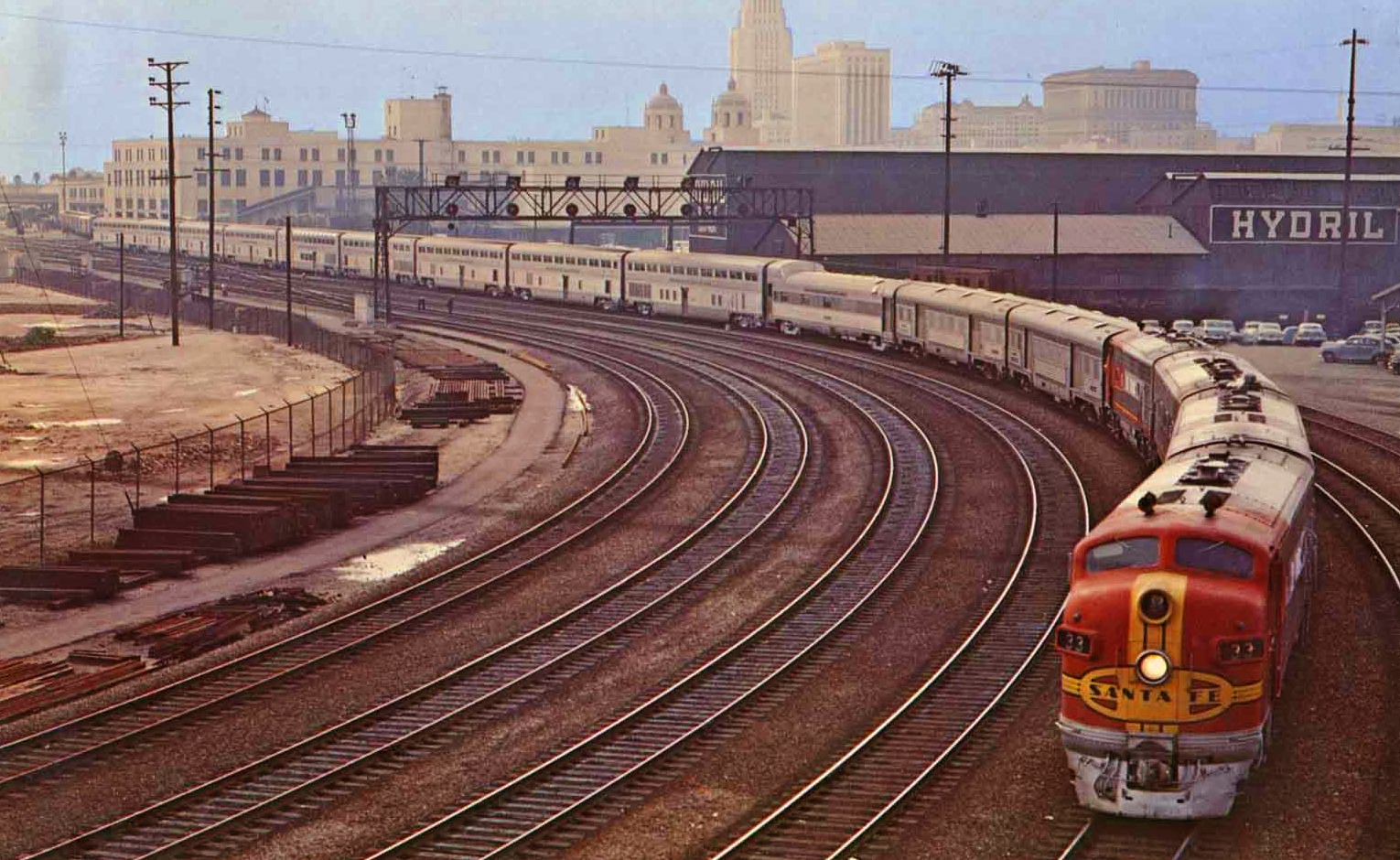Santa Fe's "Hi-Level" Cars: Specs, History, Photos
Last revised: February 25, 2025
By: Adam Burns
The Hi-Level was a type of passenger car operated by the Santa Fe. Introduced in 1956, these cars were distinguished by their two-level design, which was intended to provide a superior view of the passing scenery.
The bi-level design was revolutionary for its time; while such cars had been used in commuter service for sometime they had never before been applied to a long-distance train as Bob Johnston, Joe Welsh, and Mike Schafer note in their book, "The Art Of The Streamliner."
The Hi-Levels were primarily used on Santa Fe's long-distance routes, in particular the railroad's luxury coach service, the El Capitan. The design was later adopted by Amtrak for their Superliner cars still in operation today.
Interestingly, the Hi-Levels were not only innovative for their time - as a type of standard car melded with the popular domes - but also durable.
They remained in use for decades by Amtrak and the final examples were not retired until 2018 when the remaining five first class lounges - dubbed "Pacific Parlour Cars" - made their final runs on the Coast Starlight in 2018.
Photos
 A postcard from June of 1958 featuring the "El Capitan's" new "Hi-Level" cars. These remained in service well into the Amtrak era.
A postcard from June of 1958 featuring the "El Capitan's" new "Hi-Level" cars. These remained in service well into the Amtrak era.History
In the later 1940s, Santa Fe and the prolific Budd Company put forth an innovative concept to transform the way people traveled by train. They proposed the construction of bilevel passenger cars, fundamentally a radical break from single level design prevalently used back then. This marked the inception of the Hi-Level railcars that decades later would change the course of passenger rail travel.
In 1952, the Budd Company - which had long been a major supplier of Santa Fe's streamlined equipment - approached the railroad regarding the bi-level concept.
Santa Fe was receptive and in 1954, two prototypes were built and underwent a series of rigorous trial runs and tests. This was pivotal as it gave practical insight into the real-time working of these unique passenger cars and provided an opportunity to facilitate possible improvements before the full-scale production.
El Capitan
Public reception was very strong and as a result, Santa Fe placed an order for 47 additional cars which included ten 68-seat "step down" coaches, twenty-five 72-seat coaches, six lounges, and six dining cars. The total cost was $13 million. These Hi-Levels provided for five full equipment sets, enabling daily service on the El Capitan.
In their book, "Streamliners: History Of A Railroad Icon," authors Mike Schafer and Joe Welsh note the AT&SF was so confident of Hi-Levels' reception that it spared no expense in showcasing the cars at preinauguration event held in Washington, D.C. in 1956.
As many as 400 guests toured the cars - including congressmen, senators, and members of the Interstate Commerce Commission. The exhibition train was also showcased in Pittsburgh, Cleveland, Youngstown (Ohio), Detroit and Chicago.
Marketing
Once back on home rails the train was also displayed in Kansas City, Los Angeles, Pasadena, San Diego, Albuquerque, and other cities. The railroad even produced a colorful foldout featuring the Hi-Levels which read:
"'Top Of The Cap,' Hi-Level Lounge Car: El Capitan's fun car! Note the roof skylights, as well as table picture windows. On the hi-level there are 60 seats arranged individually, as well as in pairs and at tables for a foursome of bridge.
The stairway at center of car leads to the Kachina Coffee Shop on the lower level accommodating 20 more passengers. There are attendants on both levels, also on the upper level is a completely stocked newsstand.
There is plenty of room to move around in this new type lounge car and in all the other cars that make up the Hi-Level El Capitan. This roominess is just one of many features that contribute to the smooth riding comfort of El Capitan.
Dining Penthouse Style, Hi-Level Dining Car: Dining is one of your biggest thrills and greatest pleasures on your El Capitan trip. You enjoy soft music, magnificent views, and of course, tempting Fred Harvey dishes - all high above the noise of the kitchen below.
Eighty passengers can be served at one sitting in this spacious dining car and everyone is pleased with the economically priced meals."
The El Capitan officially debuted with its new Hi-Levels on July 15, 1956. The actual production of these innovative cars spanned ten yers (including prototypes) between 1954-1964. In the span of these two years, the revolutionary Hi-Level cars were meticulously built to change the course of passenger rail services in the United States.
The Budd Company produced a total of 73 Hi-Level cars for the Santa Fe. These comprised of coaches, dining cars, lounge cars, and step-down coaches, delivering a diverse set of accommodations to meet varied passenger requirements.
The cars' success made Santa Fe strongly consider reequipping its Super Chief with Hi-Level sleepers - and Budd even drew up plans for such a design in 1957. However, the idea was ultimately dropped.
The key aspect that set the Hi-Level cars apart was their distinctive bi-level design. The lower level was designed for baggage, restrooms, and additional seating, while the main seating area remained in the upper level. This design was aimed at providing passengers with a quieter, smoother ride and panoramic views.
On December 15, 1956, the first fleet of Hi-Level cars entered regular service on the Santa Fe's prestigious "El Capitan". This marked a significant milestone in the history of passenger rail services in the United States.
 In this Santa Fe publicity photo a picturesque A-B-B-A set of F3's power train #22, the eastbound "El Capitan" with its popular Hi-Level cars as the train departs Los Angeles Union Passenger Terminal circa late 1950s.
In this Santa Fe publicity photo a picturesque A-B-B-A set of F3's power train #22, the eastbound "El Capitan" with its popular Hi-Level cars as the train departs Los Angeles Union Passenger Terminal circa late 1950s.The Hi-Level cars offered various on-board accommodations to cater to the needs of the passengers. The standard coach cars consisted of an impressive 68 seats in the upper level and 14 seats along with a baggage area in the lower level.
The lounge cars featured an upstairs seating capacity of 57 passengers and could cater up to 23 diners simultaneously in the lower level dining section.
The cars' weight depended on the type; the coach weighed roughly 80 tons while the lounges weighed 83 tons, and finally the diners weighed 97 tons due to the addition of so much necessary equipment for the dining experience.
The weight ensured a stable and comfortable ride for the passengers, enhanced by the fact guests predominantly rode in the upper level which further reduced noise and improved ride quality.
Designed specifically for the Santa Fe's "El Capitan", the Hi-Level cars were considered a symbol of luxury and comfort. The "El Capitan" was known for its affordability while still offering exceptional onboard amenities.
Specifications
Original Hi-Levels
| Car Type | Number of Cars | Weight (lbs) | Length | Width | Height | Trucks and Journals | Air Conditioning Capacity (tons) | Diesel Alternators | Maximum Lighting and Miscellaneous | Electrical Air-Conditioning System | Loads (kw) Kitchen Refrigeration | Total | Fuel Capacity | Water Capacity |
|---|---|---|---|---|---|---|---|---|---|---|---|---|---|---|
| 72-Passenger Coach | 25 | 162,210 Lbs | 85' | 10' 8" | 15' 6" | 4-wheel 6 ½ x 12 | 16 | One 40-kw | 5.9 | 32.0 | - | 37.9 | 200 | 300 |
| 68-Passenger Coach | 10 | 163,160 Lbs | 85' | 10' 8" | 15' 6" | 4-wheel 6 ½ x 12 | 16 | One 40-kw | 5.9 | 32.0 | - | 37.9 | 200 | 300 |
| Sky Lounge | 6 | 176,100 Lbs | 85' | 10' 8" | 15' 6" | 4-wheel 6 ½ x 12 | 20 | One 60-kw | 6.3 | 39.3 | 1.5 | 47.1 | 275 | 300 |
| Diner | 6 | 208,600 Lbs | 85' | 10' 8" | 15' 6" | 6-wheel 6 x 11 | 20 | Two 60-kw | 5.7 | 31.0 | 48.3 | 85.0 | 550 | 800 |
Additional Cars (1964)
The Hi-Level coach cars could accommodate more than 80 passengers, a far higher capacity than traditional single-level train cars. The increased passenger capacity was one of the primary reasons behind the inception of Hi-Level cars.
In his book, "Santa Fe Railway," author Steve Glischinski notes the company remained confident in passenger rail service and continued to order new equipment during a time when most others had given up on this mode of travel.
In 1964, the AT&SF, under President Ernest Marsh, acquired 24 additional Hi-Level coaches, which enabled some of the original cars to be transferred to the San Francisco Chief. In addition, they occassionally found service on other Santa Fe trains.
Amtrak
The Hi-Levels remained in regular service throughout the AT&SF era and well into the Amtrak years. In fact, the car inspired Amtrak's future Superliner cars. The latter, developed in the 1970s and 80s mimicked the bilevel design of the Hi-Level cars to enhance journey comfort and expand accommodation capacity.
Amtrak inherited the Hi-Level fleet when it took over Santa Fe's passenger operations in 1971. These cars, equipped with the trademark bilevel design, stayed in service well into the new millennium, a testament to their durability and timeless appeal.
Amtrak continued to utilize the last of the Hi-Level lounge cars until 2018, marking over six decades of operation. The retirement of these cars in 2018 represented the end of an era for these historical railcars that significantly influenced the course of passenger rail travel.
This concludes our comprehensive guide on Santa Fe's Hi-Level railcars. Throughout their life, these cars embodied the spirit of innovation, passenger comfort, and efficient design. Their imprints on the history and evolution of the American passenger rail system are undeniable and will continue to live on, even after their exit from the rails.
Sources
- Glischinski, Steve. Santa Fe Railway. St. Paul: Voyageur Press, 2008.
- Johnston, Bob and Welsh, Joe. Art Of The Streamliner, The. New York: Andover Junction Publications, 2001.
- Schafer, Mike and Welsh, Joe. Streamliners, History of a Railroad Icon. St. Paul: MBI Publishing, 2003.
Recent Articles
-
Rio Grande 2-8-2 Locomotives (Class K-28): Specs, Roster, Photos
Apr 14, 25 10:24 PM
Rio Grande's Class K-28 Mikados were its newest narrow-gauge steam locomotives since the Mudhens of the early 1900s. Today, three survive. -
Rio Grande K-27 "Mudhens" (2-8-2): Specs, Roster, Photos
Apr 14, 25 05:40 PM
Rio Grande's Class K-27 of 2-8-2s were more commonly referred to as Mudhens by crews. They were the first to enter service and today two survive. -
C&O 2-10-4 Locomotives: Specs, Roster, Photos
Apr 13, 25 04:07 PM
Chesapeake & Ohio's T-1s included a fleet of forty 2-10-4 "Texas Types" that the railroad used in heavy freight service. None were preserved.


